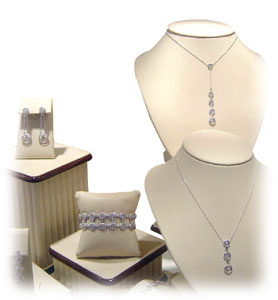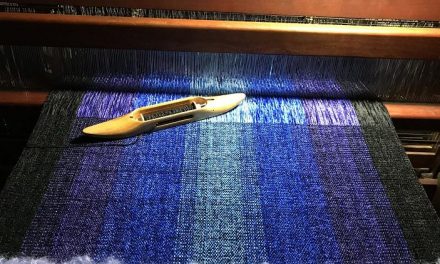So many times, beginning crafters think small. A local Christmas crafts fair held in a high school gym might be about as far as your ambition extends. And, depending on your craft, that might be as far as you can go.
But if your product is unique, beautifully made, and appeals to a wide variety of customers…then it behooves you to dream big. Don’t be intimidated by the idea that the huge, high-quality craft shows don’t want new vendors—because they do.
Small crafts fairs held in high school gyms are excellent training grounds to learn the ropes of displaying and selling your product. But you may come to a point where you wish to broaden the scope of your sales. In this case, consider doing a larger or premier event.
Not every crafter can get into a premier show by simply filling out the application form. In addition to the uniqueness and quality of the work (necessary for passing the jurying process), it takes an understanding of showmanship to successfully exhibit at the larger and more prestigious events.
I recently spoke with Howard Rose, vice president of Rose Squared Productions to get an idea of how new crafters can increase their chances of being accepted at a large show. Rose Squared Productions is a craft event promotion company in its twenty-seventh year. It produces six events per year in Essex and Union counties in New Jersey with up to 180 vendors in each show. The shows are highly regarded in the arts and crafts arena, with many of the events having been listed in the “Top 100 Shows” by Sunshine Artist magazine. Rose Squared Productions is known for its quality booth displays as well as its reputable, high-quality vendors. Each event attracts between 12,000 and 15,000 attendees.
As is typical for a large, well-regarded venue, the jurying process is stringent and the booth costs are higher. The benefit to the crafter is a guarantee that all vendors who display their work will have quality, unique arts and crafts, and that the event has the clout, finances, and self-interest to market the crafters professionally. This translates into the potential to make a great deal of money in sales.
In the case of Rose Squared Productions, in 2008 the cost was $325 for an average booth dimension of 10 feet by 12 feet. For the jurying process, applicants are required to send at least three photos of their work as well as one photo of their booth.
Why send in a photo of the booth? Rose Squared Productions, like many premier craft shows, is interested in maintaining certain standards of quality in the overall “look” of the event. “New vendors have a tendency to think they can just throw some tables together,” says Rose, “without realizing that the more professional the display, the more likely they are to attract customers into their booth.” A handsome booth is beneficial to the event producers as well as the crafter.
Rose Squared Productions encourages beginning vendors and is always on the lookout for new blood. There are no requirements for a vendor to have been in business for any length of time prior to applying; the emphasis is on quality of both booth and product. Rose Squared events focus on contemporary arts and crafts. Approximately 30 percent of its displays are photography and fine art, with the rest representing handmade crafts.
How far in advance does a vendor need to apply? “For jewelry or other popular categories,” advises Rose, “the spaces can be filled by January for the entire year’s schedule. Other categories stay open until filled.” Like most of the larger shows, Rose Squared Productions limits how many vendors they will accept in popular categories. Approximately 18 percent of its booth space is allotted to jewelry exhibitors, for example. It goes without saying that the more unique the product, the greater the likelihood that it will be juried into a show.
Since booth display and setup are so important, Rose offers the following advice. “The only consistency we require is a white canopy, unless the vendor can justify a different color. But within their booth, vendors should use space as efficiently as possible. Think multilevel or three-dimensional. Crafters pay a lot of money for their booth space, so it behooves them to use the third dimension as much as possible.” This can mean vertical displays (shelves) or items that hang or dangle.
Rose has seen jewelers with all their necklaces on a single table, “but that’s visually boring. Marketing-wise, it’s unappealing. By making their displays multilevel, vendors allow the customers to view different pieces.”
 He also cautions against cramming too many items into too small a space. “Some vendors will put out a million things and customers can’t see the forest for the trees. If there is too much stock on display, it visually cheapens the work. If a crafter frames the item with space, they’re giving it greater importance.”
He also cautions against cramming too many items into too small a space. “Some vendors will put out a million things and customers can’t see the forest for the trees. If there is too much stock on display, it visually cheapens the work. If a crafter frames the item with space, they’re giving it greater importance.”
I asked if there was any other advice that Rose can offer to new exhibitors. “Be open to suggestions,” he replied. With new vendors, he often suggests improving their booth display. Crafters need to realize that he’s there to help. They are his customers, and if they don’t sell well, they won’t come back.
“People have been rejected [from being accepted] because of their booth, even though their work is good,” explains Rose. “New crafters might want to go to a large show and see what kind of booth stops you. Is it the signage? The appeal of the displays? The layout?”
Rose Squared Productions encourages vendors to display enlarged photos of the crafters at work, often hung at the back of the booth. “These educate the public about your craft,” emphasizes Rose. “It shows the amount of work that goes into the making if your product. If you can get customers to be visually drawn into the production process, they have a better understanding of why they should spend money on your craft.”
I asked him to describe some factors that would cause a vendor to not be invited back. “Dishonesty or evasiveness on their application,” he replied promptly. “For example, sometimes a crafter juries in only one craft line but then tries to sell three or four others that weren’t listed. Applications and photos must accurately represent what a vendor is selling.” Remember, if the application asks for detailed descriptions of your product, then give it. “And some other stuff” never flies.
This is one of the most common complaints from many crafts event producers. If they spot items that weren’t listed on the application or juried in, production staff may ask a vendor to stop displaying the unjuried items. If a vendor refuses, they won’t be asked back the following year and may even be escorted off the premises in the middle of a show.
New vendors may question the emphasis that Rose Squared Production places on booth setup and display, but these requirements are common for premier crafts shows. Large, eminent craft productions stress the atmosphere and tone of the event as well as the quality of the products. They know that customers’ impressions are critical to the success of events. A show that looks cheap and shoddy because of poor-quality booth displays is not a place where people want to spend money.
It is important to understand the relationship between a vendor and an event. It is a mutually beneficial arrangement. A well-regarded arts and crafts show cannot survive without high-quality and enthusiastic vendors. And the vendors have a much more difficult time selling their products without the assistance of professional and enthusiastic promoters.
With this in mind, it is in the best interest of a vendor to listen and comply with the requests of the event promoters. Production staff do not impose rules at random in order to make your life miserable. Rather, they must conform to state and local safety regulations, as well as consider the needs of anywhere from 50 to 500 other vendors.
If a craft coordinator makes recommendations for improving the layout of your booth, don’t get huffy and assume they’re doing it to ruin your day. Rather, they are making suggestions because they feel it will improve your sales. A happy vendor with high sales is a vendor who will come back the following year.
Similarly, don’t make the job of the promotion staff difficult by adopting a diva attitude, making unreasonable demands, displaying unjuried products, or otherwise drawing undesirable attention to yourself. Regardless of how unique your product is, these types of vendors are not welcome back the following year. Event promoters are full of horror stories about difficult vendors, and they share these stories with other promoters.
Promoters talk. If you act up enough, you may find yourself blacklisted from any number of regional events. But if you are helpful, professional and cheerful, you will have very little difficulty entering any number of high-end arts and crafts shows.
With common sense, professionalism and a positive attitude, a beginning crafter’s dream of big shows can become reality. Selling at premier events can translate into a better income as well as invitations to attend other large events.
Remember, dream big!
Patrice Lewis is a wife, mother, homesteader, homeschooler, author, blogger, columnist, and speaker. An advocate of simple living and self-sufficiency, she has practiced and written about self-reliance and preparedness for almost 30 years. She is experienced in homestead animal husbandry and small-scale dairy production, food preservation and canning, country relocation, home-based businesses, homeschooling, personal money management, and food self-sufficiency. She and her husband have been married since 1990 and have two daughters.






